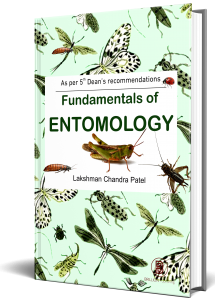The subject Entomology deals with scientific study of insects in diverse manner. The economically important insects are grouped as injurious (pest) and useful in nature. Major essential basic science of the insects need to be known in details specifically for the beginners of the said subject. Keeping in mind, Fundamentals of Entomology (As per 5th Deans’ Committee Recommendations) has been written urgently as a ready text based on nationwide updated syllabus for the UG students in Agricultural science.
Features:
- Hard endeavor has been reflected to discuss the subject materials in a systematic and comprehensive manner along with relevant pictures to make a particular topic easily digestible to the users of this book, wherever, felt necessary.
- Special attention has been drawn covering major basic necessary things apropos Insect Morphology, Insect Systematics, Insect Ecology and Integrated Pest Management (IPM). Through primary understanding of these areas of entomology can only help one to better and easy understanding as well as application of other areas of entomology in research, teaching and extension work. The above mentioned important areas of entomology have been compiled and discussed in a
- The book has been written keeping in view the requirements of the graduate, post graduate students, teachers, plant protection specialists and research scientists in entomology as per the latest updating syllabus of the 5th Deans’ Committee Recommendations.
1. History of Entomology in India
2. Major Points related to Dominance of Insect in Animal Kingdom
3. Classification of Phylum Arthropoda upto Classes
4. Relationship of Class Insecta with Other Classes of Arthropoda
5. Morphology: Structure and Functions of Insect Cuticle and Molting
6. Body Segmentation
7. Structure of Head, Thorax and Abdomen
8. Structure and Modifications of Insect Antennae
9. Structure and Modification of Insect Mouthparts
10. Structure and Modification of Insect Legs
11. Wing Venation, Modifications and Wing Coupling Apparatus
12. Structure of Male and Female Genital Organ
13. Metamorphosis and Diapauses in Insects
14. Types of Larvae and Pupae
15. Structure and Functions of Digestive System in Insects
16. Structure and Functions of Circulatory System in Insects
17. Structure and Function of Excretory System in Insects
18. Structure and Function of Respiratory System in Insects
19. Structure and Function of Nervous system in insects
20. Structure and Function of Secretary (Endocrine) System in Insects
21. Structure and Function of Reproductive System in Insects
22. Types of Reproduction in Insects
23. Major Sensory Organs like Simple and Compound Eyes, Chemoreceptor
24. Insect Ecology: Introduction, Environment and Its Components
25. Effect of Abiotic Factors – Temperature, Moisture, Humidity, Rainfall, Light, Atmospheric Pressure and Air Currents
26. Effect of Biotic Factors – Food Competition, Natural and Environmental Resistance
27. Categories of Pests
28. Concept of IPM, Practices, Scope and Limitations of IPM
29. Classification of Insecticides, Toxicity of Insecticides and Formulations of Insecticides
30. Chemical Control – Importance, Hazards and Limitations
31. Recent Methods of Pest Control, Repellents, Antifeedants, Hormones, Attractants and Gamma Radiation
32. Insecticides Act 1968 – Important Provisions
33. Application Techniques of Spray Fluids
34. Symptoms of Poisoning, First Aid and Antidotes
35. Systematics: Taxonomy – Importance, History and Development and Binomial Nomenclature, Definitions of Biotype, Sub-Species, Species, Genus, Family and Order.
36. Classification of Class Insects Upto Orders
37. Basic Groups of Present Day Insects with Special Emphasis to Orders and Families of Agricultural Importance


